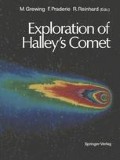Summary
The spectra of 16 bright Orionid meteors are studied in the spectral range from 3440 to 8700Å. The brightest members of the group have peak absolute magnitudes near −8, indicating masses of a few grams and providing clear evidence that large particles from comet Halley survive to encounter the Earth’s atmosphere. Spectral lines from six neutral atomic species and three singly-ionized species are observed. The Orionid spectra are very similar to Perseid meteor spectra, suggesting any differences in abundances in the parent comets appear to be marginal for the elements observed.
Access this chapter
Tax calculation will be finalised at checkout
Purchases are for personal use only
Preview
Unable to display preview. Download preview PDF.
References
Cook, A. F.: 1973, in Evolutionary and Physical Properties of Meteoroids,NASA SP-319, p. 183
Friichtenicht, J.F., Becker, D.G.: 1973, in Evolutionary and Physical Properties of Meteoroids,NASA SP-319, p. 53
Halliday, I.: 1958, J. Roy. Astron. Soc. Canada 52, 169
Halliday, I.: 1961, Publ. Dominion Obs. Ottawa 25, 1
Halliday, I.: 1969, Publ. Dominion Obs. Ottawa 25, 313
Halliday, I., Griffin, A. A.: 1963, J. Sci. Instruments 40, 187
Halliday, I., Griffin, A.A., Blackwell, A.T.: 1981, Meteoritics 16, 153
Jones, J., McIntosh, B. A.: 1987, 20th ESLAB Symp. (in press)
McIntosh, B. A., Hajduk, A.: 1983, Monthly Notices Roy. Astron. Soc. 205, 931
Millman, P.M.: 1959, J. Roy. Astron. Soc. Canada 53, 16
Millman, P. M.: 1972, J. Roy. Astron. Soc. Canada 66, 201
Millman, P. M., Halliday, I.: 1961, Planetary and Space Sci. 5, 137
Millman, P. M., McKinley, D. W.R.: 1963, in The Moon, Meteorites and Comets, ed. B. M. Middlehurst, G. P. Kuiper, University of Chicago Press, p. 674
Moore, C.E.: 1945, A Multiplet Table of Astrophysical Interest, Contr. Princeton University Observatory, No. 20
Savage, H.F., Boitnott, C.A.: 1973, in Evolutionary and Physical Properties of Meteoroids, NASA SP-319, p. 83
Author information
Authors and Affiliations
Editor information
Editors and Affiliations
Rights and permissions
Copyright information
© 1988 Springer-Verlag Berlin Heidelberg
About this paper
Cite this paper
Halliday, I. (1988). The spectra of meteors from Halley’s comet. In: Grewing, M., Praderie, F., Reinhard, R. (eds) Exploration of Halley’s Comet. Springer, Berlin, Heidelberg. https://doi.org/10.1007/978-3-642-82971-0_158
Download citation
DOI: https://doi.org/10.1007/978-3-642-82971-0_158
Publisher Name: Springer, Berlin, Heidelberg
Print ISBN: 978-3-642-82973-4
Online ISBN: 978-3-642-82971-0
eBook Packages: Springer Book Archive

